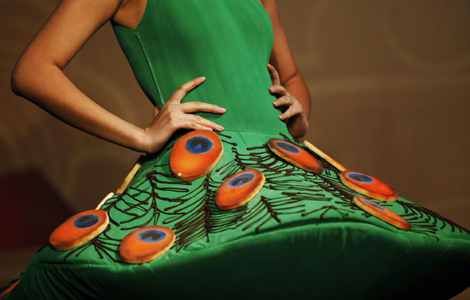American master strokes
Updated: 2011-12-16 07:47
By Liu Lu (China Daily)
|
|||||||||
|
One of Stephen Rice's works, a scroll painting of six vivid and life-like Chinese ladies, took him 400 hours to complete. [Provided to China Daily] |
US artist imbues works with passion for Chinese culture
It is a painting of very simple composition and strong color contrast, with only a bright red Coca-Cola can, a pale green rice bowl and two pairs of wooden chopsticks that are placed onto a tarnished table. The background is repetitions of the same combination.
There is no person in this picture. But the artist Stephen Rice, 43, says it is his self portrait, which relates the feeling of his many years in China.
Rice says the Coca-Cola can is a symbol of the United States, the country where he came from, and the rice bowl and chopsticks represent China, the place where he now works and lives.
"The painting is called Zhong Can (Chinese dishes). 'Zhong' means middle in Chinese - in this way it really symbolizes where I am, because right now I am kind of in the middle. I am no longer one or the other solely, " Rice says.
"Stylistically this painting is Western and Chinese, so it's about sharing the idea and culture; it's about me."
The painting is special to Rice, as it is his last piece before his graduation from the Central Academy of Fine Arts (CAFA) in Beijing last year. The picture has been rated one of the best graduation works and is now in a permanent collection of the university.
As the first non-Asian to graduate from the country's best fine arts institution with a master's degree in traditional Chinese painting, Rice says it places him in a unique position and he hopes he can one day be a liaison of culture and arts for China and the West.
Rice is right on his way to achieving the goal by influencing more people with his artistic talent and distinctive creations.
"My pictures were very heavily influenced by my experiences in China and my desire to know more about the Chinese culture.
"I was trying to see something new within myself through the eyes of a foreign culture and looking for answers and inspiration away from my own country. This has now led me back to looking at my own cultural roots and Western religious art with a new perspective."
After spending four years studying traditional Chinese painting and living in Beijing, Rice now speaks fluent Chinese and is married to a Chinese woman. He says although it was not easy for a foreigner come to China at first, he has already overcome the culture shock.
"Everything is wonderful at the beginning, but after a while, the reality sinks in. You cannot relate everything to a natural way. Many things are difficult for you to adjust to. That's exactly what culture shock is."
|
|
He says it was the passion for Chinese culture and art that drove him to travel to the capital to learn Chinese painting and other traditional Chinese art forms.
"Chinese culture offers me a chance that maybe I can see the world through new eyes. I guess that's what I was looking for - a way to change my life."
Before coming to pursue his master's degree in China, Rice gained a bachelor's degree in fine arts at San Diego State University and was a graphic designer for a few years.
Notwithstanding his solid artistic foundations and professional background, it is a great feat for a foreigner to pass the CAFA entrance exam. To do so he spent more than six months practicing Chinese calligraphy, writing a thesis in Chinese and learning about the history of Chinese art.
He sat a five-day exam, competing with 21 Chinese native for just five vacancies. Rice attributes his success to his determination. "It's not because I am that good. I think its because they (could) feel my persistence and desire to learn Chinese culture."
From the second Rice picked up a brush and brought it down on paper in his first traditional Chinese painting lesson, it was clear to him that things would not be easy. "Traditional Chinese painting is so difficult from that in the West. The rice paper gets wet so quickly, and (you) can't control the ink It's so frustrating at the beginning. Acquiring the skill required patience and countless hours of practice."
Tang Yongli, a CAFA professor who taught Rice, and who is one of the country's foremost traditional Chinese artists, speaks highly of his student.
"He has a talent in painting and coupled with his diligence, he was one of the best students in class," Tang says. "His Western way of thinking has also injected new vitality to his works to make them stand out from those of his classmates."
Tang says Rice has developed a distinctive painting style that is Chinese traditional painting mixed with Western painting characteristics, which gives them a high degree of appeal in the market.
However, Rice did not go straight to the art world as soon as he graduated. He chose to become a full-time English training manager at Antal International in Beijing. As the leader of a seven-member team, Rice now teaches corporate executives how to use English in business and helps them improve English communication skills.
That does not mean he has given up painting. He does so whenever he is free and holds occasional exhibitions.
He has held four art shows. Some of his paintings have been displayed in the 798 Art Zone, a thriving arts community in Beijing. His works have awed many visitors with his strong command of traditional Chinese fine brush painting skills.
"Visitors are surprised to know these Chinese brush paintings of vibrant colors and smooth lines were drawn by an American," says Li Xiangyan, the owner of Shui Ling Lan gallery, who is the organizer of the exhibition.
Li says the pictures were incredibly "Chinese", and it was clear from the quality how much effort Rice had put into his work.
"The one that attracted most people's attention was a scroll painting of six vivid and lifelike ancient Chinese ladies, which took Rice 400 hours to complete," Li says.
With the strong public response, Li realized that Rice's works have tremendous market value, and she plans to put on more of his solo exhibitions.













